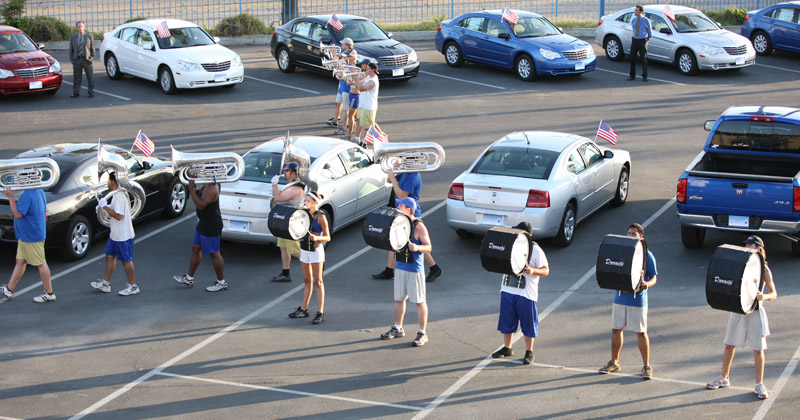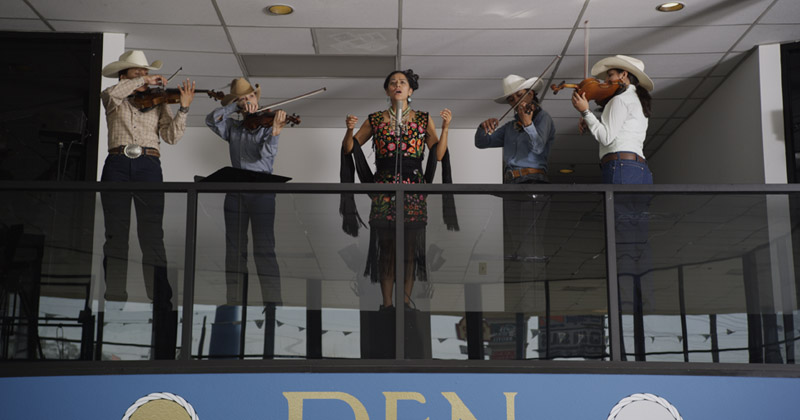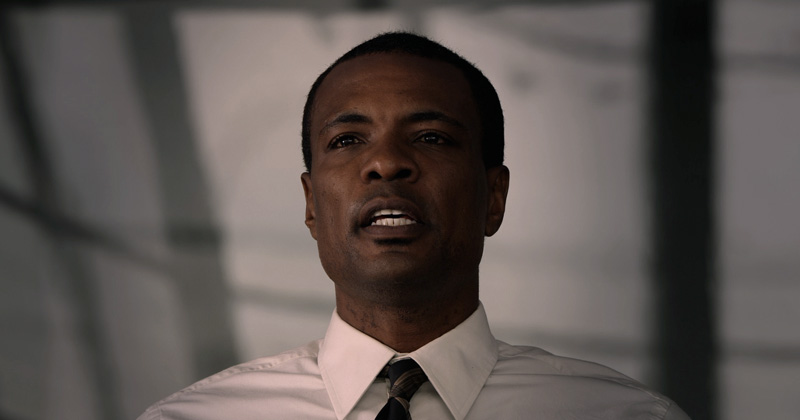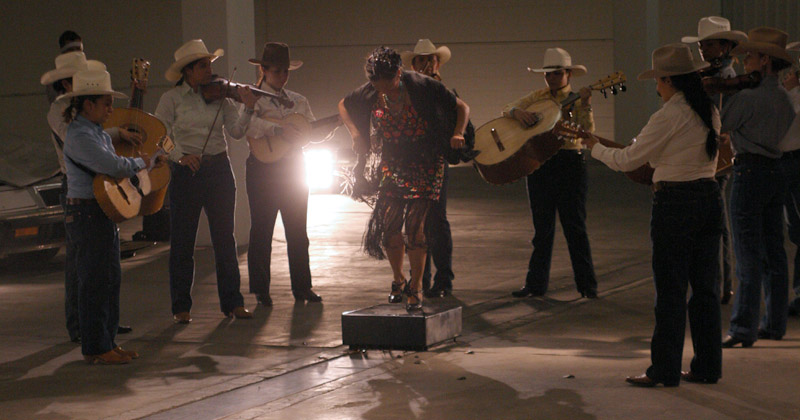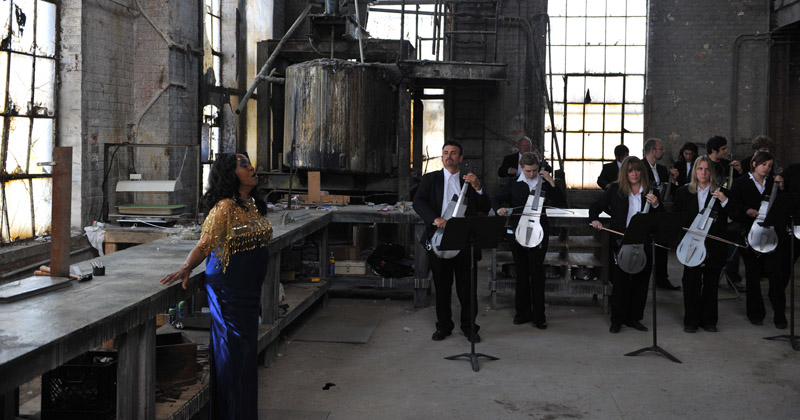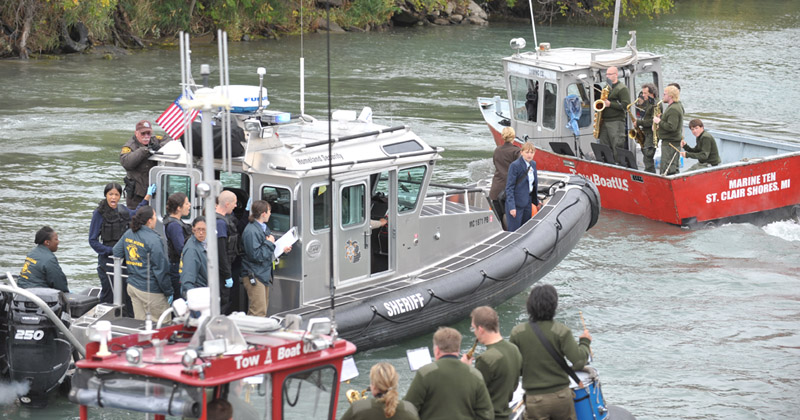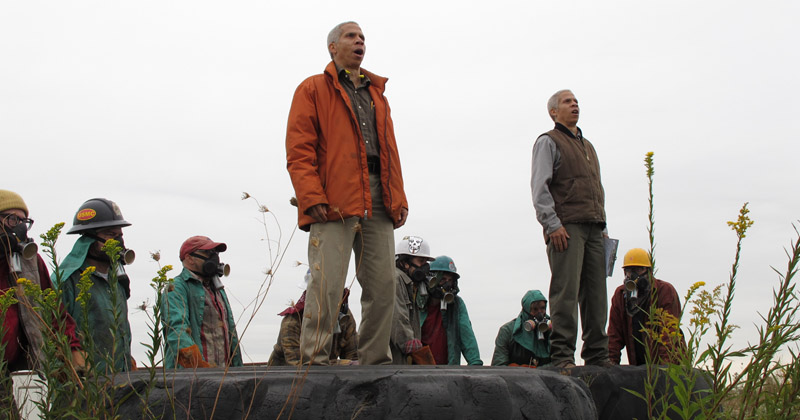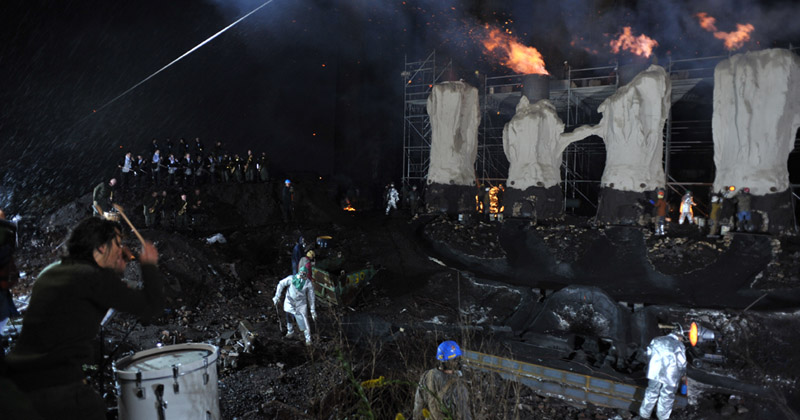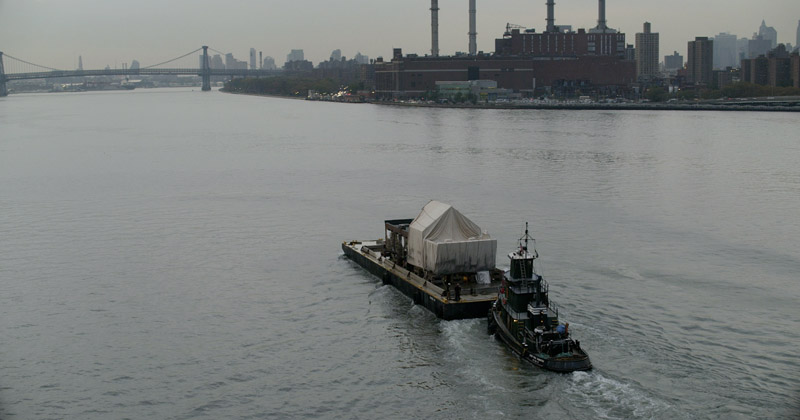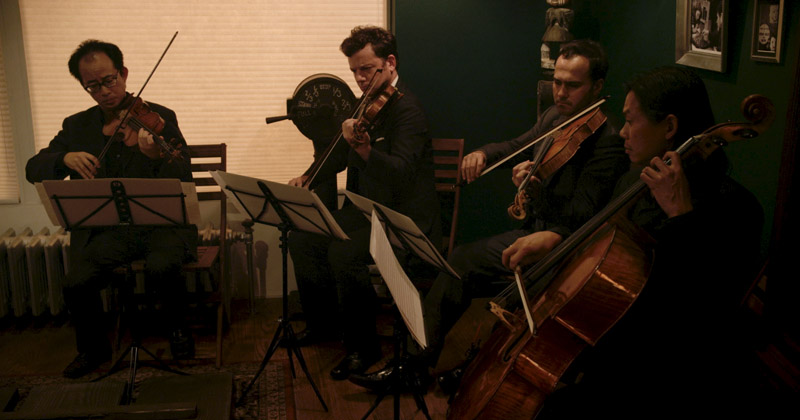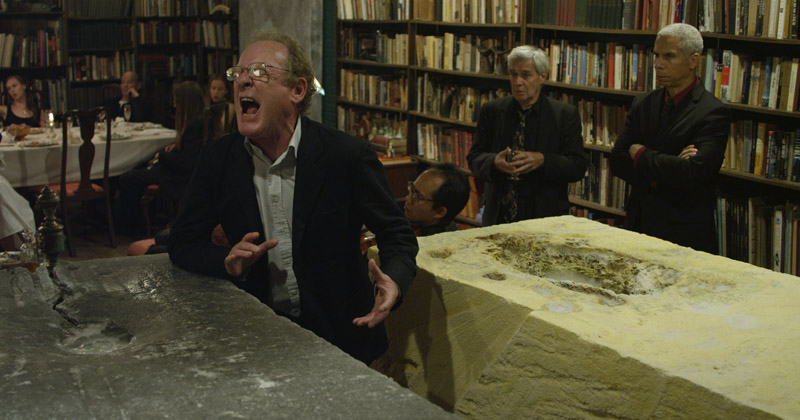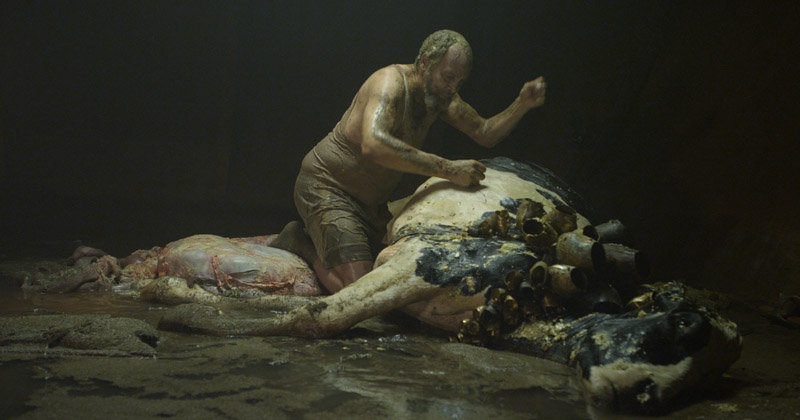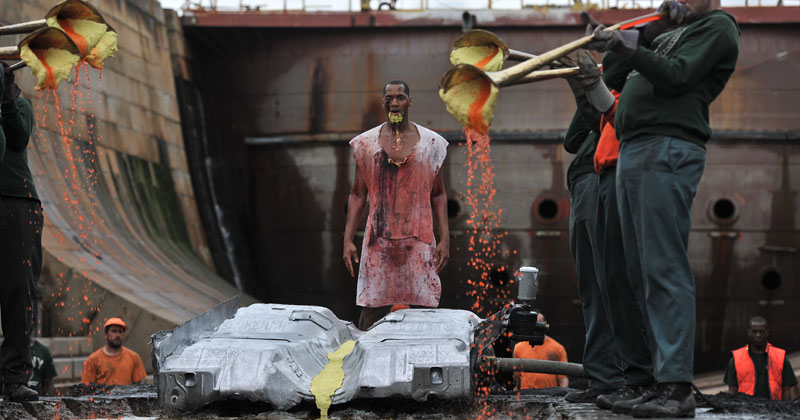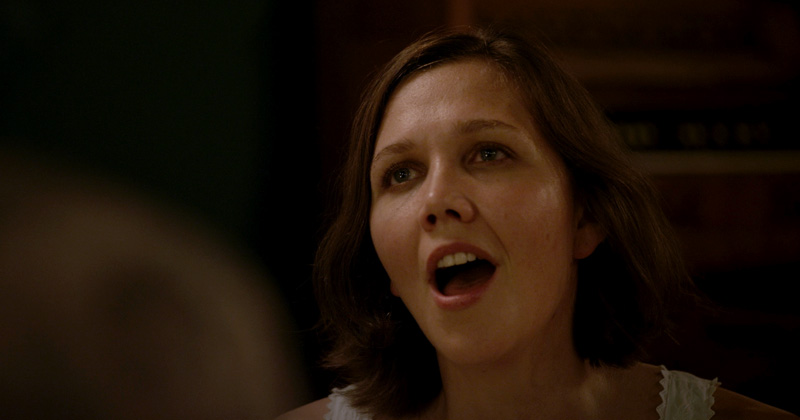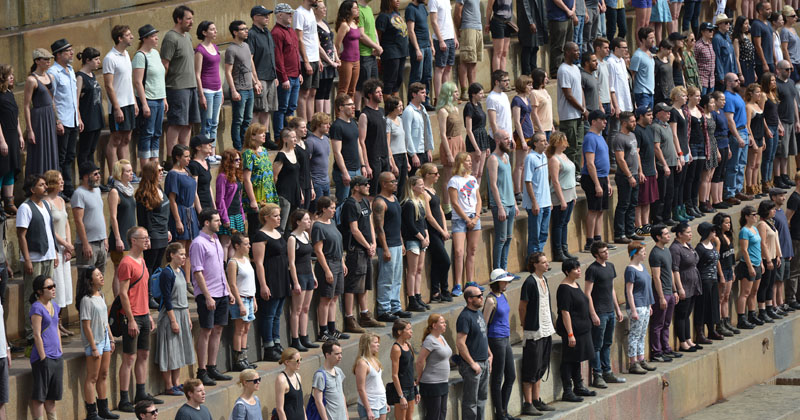Drawing from West Coast themes such as car culture, Mexican-Americana, youth and sports, and film industry trappings, the musical language of the Los Angeles action includes a precision drum and bugle corps, an all female mariachi orchestra, a chorus of auto salespeople, and percussion instruments built into the walls of an auto showroom. Mailer's text is set in hybrid operatic contexts, including a half-sung speech by a sales manager, a ranchera tune, a musical theater ensemble number, and an impressionist aria by a Mexican-American folkloric singer.
As a crowd gathers in the Ren Dealership parking lot to witness the performance, sections of a precision drum and bugle corps are heard approaching from all sides. Their sounds mix with highway traffic and echo through asphalt and concrete as they gradually make a choreographed convergence on the site. They take up formation before the audience and perform a deconstructed showpiece in introduction to the Manager's speech.
A dark passage from Mailer's text beginning 'crude thoughts and fierce forces are my state' is sung in Spanish translation by a Mexican-American folkloric singer (Lila Downs), to the accompaniment of an all-female Los Angeles mariachi group. The song is a grave, off-kilter variant on the tragic ranchera lament.
At the REN site in Los Angeles, the crowd arrives to be greeted by actors dressed as showroom salespeople. This 'sales team' function as ushers, guiding the audience to their places before the performance begins. In the showroom the singers each begin a different showtune on the same text - a layered chorus of individual expression where each single voice functions only as part of the whole.
In a cavernous interior space at the heart of the compound, all musicians and singers are positioned around the room in a surround formation, passing tones and abstract sounds from point to point. As a soloist moans 'thirst is in the rivers of the body', the band and mariachi musicians shift places around the room. The piece accumulates into concerted crescendos as the singer stamps out rhythms on the floor.
The musical approach in Detroit draws on the promise and inevitable failure of the American industrial ideal. The city's manufacturing sites, shipping and sewage arteries, and natural environments both pristine and polluted are a backdrop for the genre form of crime drama. Music is integrated into labor and manufacturing processes: workers manufacture instruments during a performance; vocalists form a chorus of police investigators; large-scale instruments are embedded in the architecture of a working foundry. Classical baritones, a 'hollerin' champion, and a soul diva perform vocal solos that expand on traditional operatic form.
At an abandoned factory, specially designed metal viols are being constructed in a low-tech assembly line. As an instrument is completed, a quality control player arrives and begins a simple musical line. As each new instrument comes off the line, another musician joins the ensemble to make a duet, trio, quartet and finally a 16-piece string orchestra. The length and counterpoint of the piece is determined by how long it takes to finish each instrument. A soul singer (Belita Woods) arrives and sings an aria/incantation to this accompaniment. Her song is gradually overtaken by a trombone ensemble playing from the basement of the factory.
A chorus of police investigators made up of Detroit singers performs a call and response with an alt-country singer (Jennie Knaggs) in the role of Nephthys. Discordant horn sounds are heard from afar, as saxophone and percussion quintets, formed by members of New Music Detroit and the Detroit Symphony Orchestra, arrive on rescue boats and circle the investigators. An ensemble of metal viols accompanies from the barge. The music was made in open sections to account for space and time variations in the performance. Most of the choral music was not notated and was developed in rehearsal sessions with Bepler and the singers.
A barge carrying performers and audience members drifts down the Detroit River, where an operatic bass-baritone in the role of Set (Herbert Perry) accosts them from the riverbank. The soloist sneers and hurls insults at the characters on the barge, in a strange, vulgar 'recitative' scene, placing the cast and audience on the barge in a position of submission. A group of 'breath workers' surrounds Set, wearing industrial respiratory masks fitted with reeds. Their breathing causes wheezy, rattling chords in support of the soloist. A double of Set appears (the vocalist's twin brother Eugene Perry), and together the double character continues a malign duet with himself, while Isis, Nephthys and the chorus sing layered laments.
At a primitive foundry constructed on the site of a defunct steel plant, musicians positioned around the site mix with ironworkers preparing a massive casting. Some play percussion with industrial objects, some wear fire suits and manipulate objects close to the hot metal. Performers atop 130-foot towers send objects jangling down the lengths of longstrings strung down to the ground, where musicians strum, bow, and scrape. As fires roar, tools clang, and rain pours down, the vocal, industrial, and instrumental sounds create a rich, immersive, and jarring antiphonal symphony.
Scenes set in New York derive musical influence from progressive arts culture in late 20th century, the funerary wake, parlor music, ancient Egypt, zombies, improvised music and free jazz, and American pioneers from various eras. Music emerges from sources including an experimental classical house band, Native American singers, an iconic jazz drummer, a step-dance team, a children's ensemble of toy instruments and bent circuits, bodily orifices, and architectural objects. Mailer's text is expressed in disparate ways, including explorations of singing by non-singers, a grind-core squealer, experimental vocalists, an 80s pop icon, a beat poet, R&B crooner, operatic countertenor, and a chorus of hundreds of spectators.
At Mailer's wake, musicians including a string ensemble, a harpist, an organist, vocalists, and horn players occupy ambiguous roles: they might be guests of the widow or hired entertainers at the wake; or they might be seen as an operatic orchestra. As agents of the musical trajectory, their presence evolves over the course of the scenes. They begin by tuning their instruments in preparation for performance, but it is soon clear that the tuning sounds are part of the composition. As the night wears on, both their activity and sounds become more dissonant. Musicians cohere and recede in and out of the narrative, becoming central figures at moments, and background at others. The narrative creates space for musical expression, just as the music allows characters to articulate narrative.
Late in the Mailer wake, a sense of corrosion and decay has begun to take hold in the room. The steam heating system hisses and sputters and two musicians are adjusting valves, tuning and modulating the radiators like a musical instrument. Trumpet player Axel Dörner begins to play aspirating tones in duet with the sounds of the room. Experimental vocalist Phil Minton performs a solo with this accompaniment as the rest of the singers and musicians sleepily scrape and grumble. The actors at the table continue half-sung dialogue amidst all of this, while in the next room a percussionist thumps on the wall and a teenager mouths a masturbatory beatbox sequence.
Norman II (legendary percussionist Milford Graves) emerges from the carcass of a cow, slapping and grasping the hide in an irregular cadence. He removes a set of cowbells from the carcass and wears them around his neck. Norman II communicates through percussion and a language of chanting in a post-jazz style, shamanistically transcending to a sound-world beyond. He activates whatever surface is present in the scene: bangs on walls, found objects, a hybrid drum set, a boiling pot. In his final scene, a step-team summons Norman II, and his beats and sounds overlap with their tightly regimented stomping, dancing, cheering, and clapping.
At a dry dock in the Brooklyn Navy Yard, the character Horus (classically-trained countertenor Brennan Hall) vomits liquid sulfur into a mold. He is surrounded by an ensemble of sanitation workers who are playing large, crude horns that were hand-made in an earlier scene. As they blow a strange fanfare, liquid sulfur streams from the horns and into the mold. As the scene progresses, the sulfur begins to dry and accumulate around the bell of the horns, causing the sound of the instruments to modulate and become higher and more brittle. This scene is one of many where the musical composition is not separable from the narrative and sculptural qualities of the instruments used. As the sound of the horns grows higher, Horus' singing becomes drier and thinner and almost impossibly high.
At the wake, the second iteration of Hathfertiti (Maggie Gyllenhaal) performs a dialogue that elevates into an aria. The actress intones in a naked, unrefined voice, while around her, a chorus of mythological figures engages in sexual acrobatics. Body parts and orifices are played like instruments, mingling with a classical string section. Sounds of sexual ecstasy, moans, hums, and spraying urine culminate, as her aria becomes an ecstatic scream.
At the Brooklyn Navy Yard, a crowd of spectators has gathered for a competition. These witnesses act as a classical chorus, commenting on the action as it unfolds. They soon begin to chant, shout and sing, as the scene moves further and further into a musical world.

